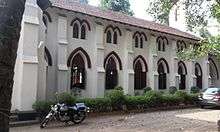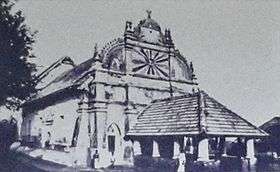Christianity in Kerala


Christianity is the third-most practised religion in Kerala, accounting for 18% of the population according to the Indian census.[1] Although a minority, the Christian population of Kerala is proportionally much larger than that of India as a whole. A significant portion of the Indian Christian population resides in the state.[2][3]


History
The tradition of origin among Saint Thomas Christians relates to the arrival of Saint Thomas, one of the 12 disciples of Jesus at the ancient seaport Muziris on the Kerala coast in AD 52[4] which is in the present day Pattanam, Kerala.[5]
The Saint Thomas Christian tradition has historically been, as recorded by scholars, that Thomas converted 12-13, in some accounts 32, Brahmin families/clans including Pakalomattom, Sankarapuri, Kaliyankal, Kalli, Kalikay, Kottakali, Koyikkam, Madeipur, Muttal, Mullamangalath , Nedumpally,Thamarassery, Powathikunel, Panakkamattam and Thengummoottil from which many Saint Thomas Christians, particularly those from prominent families, have traditionally claimed descent.
The six families Sankarapuri, Mullamangalath, Pakalomattam, Powathikunel, Kalli, and Kaliyankal were considered particularly preeminent, and historically the most aristocratic Syrian Christian families tended to claim descent from these families. Of these, the Powathikunel family is the only one that has maintained its original structure to date, the current head being Aby Philip Thomas of the Nalukettil branch.[6]
There is no contemporary evidence showing that Thomas had been in the subcontinent, but it was possible for an Aramaic-speaking Jew from Galilee to make such a trip to Kerala in the 1st century. The Cochin Jews are known to have existed in Kerala around that time. The earliest known source connecting the apostle to India is the Acts of Thomas, likely written in the early 3rd century, perhaps in Edessa.
The text describes Thomas' adventures in bringing Christianity to India, a tradition later expanded upon in early Indian sources such as the "Thomma Parvam" ("Song of Thomas"). Generally he is described as arriving in or around Maliankara and founding Seven Churches, or Ezharapallikal: Kodungallur, Kollam, Niranam, Nilackal (Chayal), Kothamangalam, Kottakkavu, Palayoor and Thiruvithamcode Arappally (a "half church"). A number of 3rd- and 4th-century Roman writers also mention Thomas' trip to India, including Ambrose of Milan, Gregory of Nazianzus, Jerome, and Ephrem the Syrian, while Eusebius of Caesarea records that his teacher Pantaenus visited a Christian community in India in the 2nd century.There came existence christian community who were mainly merchants. Other main places where churches were built are Angamaly(now) , AD300 Ambhazhakkad (a place near chalakudy) and and other parts of kerala.
While some historians have contended that there was no significant Brahmin presence in Kerala in the first century A.D. and have disputed the historicity of the Brahmin conversion tradition, there is evidence that some St Thomas Christians observed Brahmin customs and were granted privileges usually reserved for Brahmins in the Middle Ages, i.e. after the 9th century A.D., including the wearing of the sacred thread and having a kudumi.
The medieval historian Pius Malekandathil believes these were customs adopted and privileges won during the beginning of the Brahmin dominance of medieval Kerala. He argues that the St Thomas Christians, integrated with Persian Christian migrant merchants in the 9th century, had become a powerful trading community by this time and were granted the privileges by the Brahmins and the Hindu rulers to promote revenue generation and to undermine Buddhist and Jain traders who rivalled the Hindus for religious and political hegemony in Kerala at the time.
Some writers believe that the original converts would have included the Jews already present in Kerala at that time.[29] Indeed, a version of the Songs of Thomas or Thomma Parvam, written in 1601, is believed to be a summary of a larger and older work, narrate the conversion of 40 Jews along with the Brahmins and the local King at Kodungallur by St Thomas, - it claims numbered around the Hindus converted 3000. The Thomma Parvam further narrates St Thomas's mission in South India and states that before his martyrdom at Mylapore in present-day Chennai, Tamil Nadu, he had converted 6,850 Brahmans, 2,800 Kshatriyas, 3,750 Vaishiyas, and 4,250 Shudras.
The tradition of the coming of a foreigner by the name 'Thoman' who debated with the Brahmins and converted many 'prominent people' including a King is part of Nambudiri Brahmin folklore and is found in the important Nambudiri Brahmin 17th century tract the Keralolpathi.
Denominations
Saint Thomas Christian denominations
East Syrian Rite
West Syrian Rite
- Malankara Jacobite Syrian Orthodox Church
- Malabar Independent Syrian Church
- Malankara Mar Thoma Syrian Church[8]
- Malankara Orthodox Syrian Church (Indian Orthodox Church)[9]
- Syro-Malankara Catholic Church
Roman denomination
Anglican denomination
Protestant denominations
- Assemblies of God
- Church of God (Full Gospel) in India
- Heavenly Feast Church
- Indian Pentecostal Church
- The Indian Pentecostal Church of God
- Kerala Brethren
- Local Churches
- The Pentecostal Mission
- St. Thomas Evangelical Church of India
- Salvation Army
- Sharon Fellowship Church
- Yuyomaya Sabha
Pilgrimage sites
- Jacobite Syrian Cathedral Kundara
- Dolours Basilica (Syro Malabar Rite), Thrissur
- St. Antony's Catholic Church (Latin Rite), Thrissur
- St. George's Forane Church (Syro Malabar Rite), Angamaly, Eranakulam
- St Mary's Forane Church, Korratty, Thrissur (The Lurthe of Kerala)
- St. Peter's & St.Paul's Syrian Orthodox Church, Parumala, (tomb of St Gregorios of Parumala)
- Niranam Church St. Mary's Orthodox Syrian Church, Niranam founded by St. Thomas in AD 54
- Aruvithura St. George's Syro-Malabar Catholic Forane Church
- Marth Mariam Jacobite Syrian Cathedral Church, Manarcad. (Global Marian Pilgrim Center)
- Orthodox Pazhaya Seminary Chapel, Kottayam
- St. Mary's Orthodox Valiya Cathedral Kumbazha, Pathanamthitta †( Holy Remnant Of St. Thomas Apostle & foundation laid by Parumala Thirumeni)
- Saint Thomas Syro-Malabar Catholic Church, Malayattoor, (built at an altitude of 600 meters from mean sea level.)
- Manjanikkara Dayara, Omallur, Pathanamthitta, (tomb of St Ignatiaus Elias 3rd Patriarch)
- Martha Mariam Orthodox Church, Thevalakkara Mar Abo Pilgrim Centre
- St. George Syro-Malabar Catholic Forane Church, Edappally
- St. George Orthodox Church Puthuppally Pally (Global Georgian Pilgrim center)
- St. Thomas Orthodox Cathedral,Kadampanad Valiya Pally Tomb of: Mar Thoma III founded in AD325
- St. Peter's & St. Paul's Syrian Orthodox Church, Kolenchery
- St. George Jacobite Syrian Orthodox Church, Kadamattam (famous for Kadamattathu Kathanar)
- Mar Thoman Syrian Church (Cheriapally), Kothamangalam (tomb of Eldho Mor Baselios)
- St. Antony's Forane Church, Ollur
- St Mary's Jacobite Syrian Valiyapally, ThamarachalAluva (Girdle of St Mary)
- St Thomas Jacobite Syrian Church, North Paravur (tomb of Gregorios Abdul Jaleel)
- St. George Orthodox Church, Chandanapally
- St. George Orthodox Church, Cheppad (12th century murals and tomb of Mar Dionysius IV)
- St. Francis C.S.I. Church, Fort Kochi, built in 1503 C.E., is the oldest European church, declared as a National Monument in India.
- St.Jude Shrine Aaroor,Koothattukulam(Under Holy Jacobite Church)
- Syro-Malabar Catholic Church, Mannanam, Kottayam
- St. Alphonsamma Syro-Malabar Catholic Church, Bharananganam, Pala(where the remains of St.Alphonsa are buried; the first woman Saint of India.)
- Basilica of Our Lady of Ransom, Vallarpadam, Ernakulam
- St. Mary's Latin Catholic Church Thankey, Cherthala.
- St. George Syro-Malabar Catholic Church, Edathua.
- St. Antony's Latin Catholic Church, Kaloor, Kochi.
- St. Mary’s Jacobite Syrian Church Kattachira, Kayamkulam (tears flowing from the eyes of St Mary's Photo)
- St. Joseph's Latin Catholic Shrine, Kannamaly, Kochi
- Holy Cross chapel, Mattancherry.
- Marth Mariam Syro-Malabar Catholic Forane Church, Arakuzha, estd. 999
- Marth Mariam Syro-Malabar Catholic Forane Church, Kuravilangadu
- St. Mary's Syro-Malabar Catholic Forane Church, Athirampuzha, Kottayam. Estd: AD 8
- Potta Ashram, Potta, Thrissur
- Divine retreat centre, Muringoor, Thrissur
- Jerusalem Retreat Centre, Thalore, Thrissur
- St.John's Forane Church, Parappukara, Thrissur
References
- ↑ "Census of India". Retrieved 2009-04-12.
- ↑ "Christianity in India". Members.tripod.com. Retrieved 2013-12-16.
- ↑ Compiled by Robert Eric Frykenberg (2005-07-01). "Timeline". Ctlibrary.com. Retrieved 2013-12-16.
- ↑ The Encyclopedia of Christianity, Volume 5 by Erwin Fahlbusch. Wm. B. Eerdmans Publishing - 2008. p. 285. ISBN 978-0-8028-2417-2.
- ↑ "National: Pattanam richest Indo-Roman site on Indian Ocean rim". The Hindu. 2009-05-03. Retrieved 2016-02-25.
- ↑ Oomen, K.M. (2008). The History of The Powathikunel. Mavelikara.
- ↑ World Christian Encyclopedia , Second edition, 2001 Volume 1, p. 368-371
- ↑ "Mar Thoma Syrian Church of Malabar". Marthoma.in. Retrieved 2013-12-16.
- ↑ "Malankara Orthodox Church - Kottayam Seminary". Malankaraorthodoxchurch.in. Retrieved 2013-12-16.
Further reading
- George K.M.,`Christianity in India Through the Centuries`,Authentic Books, Secunderabad,2007,2009.(ISBN 978-81-7362-786-6).
- Benedict Vadakkekara,`Origin of Christianity in India`,Media House, Delhi,2007.ISBN 81-7495-258-6.
- Agur C.M.,`Church History of Travancore`,Madras,1903 Reprint:Asian Educational Services, New Delhi,1990. (ISBN 81-206-0594-2).
- Visvanathan Susan,`The Christians of Kerala`,Oxford University Press, Delhi1993,1999.(ISBN 0195647998)
- George Menachery,`The St. Thomas Christian Encyclopaedia of India`,SARAS,Ed.Prof. George Menachery, Ollur,Vol.I 1982, Vol.II 1973, Vol. III 2009.
- George Menachery,`Indian Church History Classics`,SARAS,Ed.Prof. George Menachery, Ollur,Vol.I The Nazranies 1998.